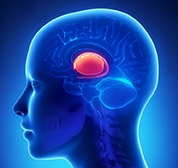Rutgers researcher hopes to uncover hidden brain functions with a $3.4 million NIH grant
One of the final frontiers of science is the human brain. The brain is the source of our intelligence, feelings and ability to make our bodies move – as well as the locus of terrible diseases such as Parkinson’s and Alzheimer’s – and is as complicated as any object that scientists explore.
James M. Tepper, a professor of neuroscience at Rutgers University-Newark, is one of those explorers. For more than three decades, he and his colleagues have added to understanding of the brain and its innermost workings, much as explorers on ships added methodically to long-incomplete maps of the New World. The voyagers documented land masses and waterways. Tepper maps the myriad electrical impulses that course through the brain.
“It’s a bit like someone handing you a circuit without a circuit diagram,” Tepper explains, “but you have the circuit board in front of you, and you have volt meters and stimulators. Your job is to be able to decode the circuit and try to figure out what connects to what and, when it does connect there, what does it do.”

Experts say that learning more about the basal ganglia is essential to uncovering the mysteries of Parkinson's.
So intricate is Tepper’s work that he doesn’t even study the entire brain. His territory is the striatum, the largest portion of the basal ganglia, a set of structures below the cerebral cortex involved in voluntary motor behavior as well as cognition, learning and memory, emotion and motivation. (photo:Experts say that learning more about the basal ganglia is essential to uncovering the mysteries of Parkinson's.)
Parkinson’s disease, which experts say affects more than six million people around the world, can progressively degrade many of those functions, a primary reason why last September the National Institutes of Health awarded Tepper a five-year, $3.4 million grant to delve ever more deeply into the circuitry and function of the striatum.
“The NIH is well aware that the basal ganglia probably hold the key to finding a pathway to curing Parkinson’s,” says Denis Paré, director of the Center for Molecular and Behavioral Neuroscience at Rutgers University-Newark. “Jim Tepper has distinguished himself over many years as a leader in unlocking the secrets of the striatum and the basal ganglia.”
One way to understand Parkinson’s, according to Tepper, is to think of the screeching feedback that reverberates through a room when a microphone is held too close to a very loud speaker. Until it subsides, the senses of people in the room are overwhelmed. The process in the brain is, of course, much more complicated, but Tepper says “a feedback loop gone crazy” is an essential mechanism of Parkinson’s.
In a brain that functions normally, the billions of electrical impulses that neurons generate each second are generally independent of one another. But in Parkinson’s, for unknown reasons, many of the impulses occur simultaneously, synchronize with one another and then bounce back and forth in unison between brain structures called the subthalamus and the globus pallidus, and elsewhere, generating their own form of pathological feedback.
Tepper says this “perfect storm” then overwhelms the brain’s ability to focus on muscle movement, memory and more. Unfortunately, the brain does not have a simple volume control to tame the howling neurological noise, a problem that probably cannot be solved at least until researchers like Tepper can fill in more gaps in the map of the brain’s circuitry.
Tepper’s role is especially important given the complexities of another potential path to solving Parkinson’s. Unlike Huntington’s disease, whose origins have been traced to mutations in a single gene, Tepper says Parkinson’s comes from a constellation of genes, making it difficult to pinpoint specific genetic defects and produce gene-based therapies to reverse them. So in the quest for a Parkinson’s cure, mapping the circuitry of the brain may be the most promising option, at least for the foreseeable future.
New tools are helping. One that excites Tepper is the ability to spot previously unidentifiable cells through genetic manipulation that turns cells with particular properties bright green when they are seen through a microscope. With that technique, Tepper and his team uncovered “several new kinds of cells in the striatum that nobody had ever been able to record from because there was no way to look at them and identify them or record their physiological properties.” Also, by inserting a light-sensitive bacterial protein called channel rhodopsin – similar to the light-sensing protein found in the retina of the eye – into cells whose characteristics they want to examine, Tepper has been able to cause specific neurons to fire under controlled conditions by shining laser light on them. Each technique helps to identify just a bit more of the circuitry that governs brain function.
Tepper’s work to reveal the intricacies of the brain has been long and painstaking, and will continue to be. “We don’t have patients,” he emphasizes. “We have cells and microcircruits.” On its own, Tepper says, his research will not uncover cures for Parkinson’s and other maladies that originate in the brain. But, he adds, “To understand what Parkinson’s disease is and how it comes about, one of the things you have to understand is how the striatum works. That is what we work on.”
Few are better positioned to succeed than Tepper, according to colleagues. “If Jim Tepper can uncover truly important mechanisms within the brain that were previously unknown and help pave the way to a Parkinson’s cure,” Paré says, “he will earn the gratitude of future researchers and patients alike.”
For more information, please contact Rob Forman of Rutgers Media Relations at 973-972-7276 or robert.forman@rutgers.edu


